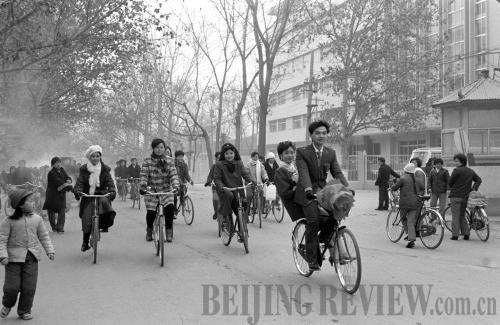|
 |
|
HEADING HOME: A bridegroom heads home with his new bride on the back of his bicycle in Xi'an, Shaanxi Province, during the Lunar Chinese New Year of 1990. Bicycles used to be popular props for weddings in China (XINHUA) |
I like to ride a bicycle in Beijing. But in the last 10 years automobile traffic has increased noticeably. When I go to Hohhot to stay with friends, I've noticed more cars on the streets. Bicycles are no longer the primary mode of transportation in China. This makes me sad; one reason I love China so much is because I can get around town using my bike, or using public transportation. Chinese cities are unlike U.S. cities, where I need my car to go anywhere at all.
Yet the Chinese did not enthusiastically adopt this Western contraption—the bicycle. Early versions of bicycles were not very practical or comfortable. In the past, bicycles seemed clumsy and undignified for traditional Chinese.
In 1817 Baron von Drais invented the bicycle prototype—a "walking machine" with two wheels but no pedals. Riders pushed forward with their feet, rather like manual scooters. Because of its impracticality, these machines never became popular.
In 1865 another wooden forerunner of the bicycle arrived. This "Boneshaker" had pedals directly attached to the front wheel. With metal tires rolling along cobblestone roads, the Boneshaker was a jarring ride.
Another prototype-a metal device, appeared in 1870. With front wheel pedals and a large rubber front tire measured to equal a man's leg length, and a smaller rear tire, it was slightly easier to ride. People called the mechanism a bicycle. They were expensive but became popular among wealthy young men in the 1880s.
Over time, inventors designed a larger back wheel than front wheel, and called them "safety bicycles." These bikes evolved into machines with two identically sized wheels. Then sprockets appeared, making riding easier and more efficient. But early bicycle tires were hard rubber, and spokes had yet to be invented.
Then the Irish veterinarian Dunlap (now Dunlop Tires) invented the pneumatic tire. Bicycles then became extremely popular, combined with more efficient shafts and chains. The craze even impacted women's fashion, as it was impossible to ride one wearing a corset and bustle. Susan B. Anthony said, "The bicycle has done more for the emancipation of women than anything else in the world." Bicycles influenced road construction: American bike fans lobbied for better roads. Children also wanted to ride with their parents, so designers began creating bikes for them after World War I.
But in the late 1800s, only foreigners living in Shanghai rode bicycles. This curious sporting phenomenon startled traditional Chinese. Then it was considered unseemly to sweat and exert oneself in public. Instead, a gentleman rode in a sedan chair, or in a rickshaw.
In China, in the 1900s, things began to change. A few wealthy Chinese began to buy expensive, imported bicycles, due to their growing international popularity. The trend caught on with ordinary Chinese people in the 1920s, when urban working people seized on the bicycle as a way to relax and move about on their days off.
In China, the bicycle industry really took off in the 1930s, as foreign bicycle plants became established. Within 10 years, Chinese domestic bike factories abounded. After 1949, the Party promoted the bicycle as the "people's vehicle." Massive bicycle production began, along with city planning that designed roads and routes for bicycle commuters. By 1958, China produced more than 1 million bikes a year.
In 1989, more than 60 percent of the Beijing residents rode bicycles; China had more than 4 million bicycles. But today, most Chinese dream of owning and driving a car. In 2010, only 19.7 percent of Beijing residents rode bicycles. The Chinese craze for cars has created traffic problems and pollution. Cars are everywhere: China's Association of Automobile Manufacturers says the country surpassed the United States as the world's biggest auto market in 2009. Chinese auto sales totaled 13.64 million, a 46.15 percent surge from 2008. Consequently, Beijing city planners are trying to encourage locals to return to cycling rather than use cars, in the hopes of reducing pollution and traffic jams. Part of Beijing's current urban plan includes setting up rental stations around the city to promote more bicycle riding.
As a foreigner, I understand the attachment to cars. Automobiles provide luxury, comfort, no physical exertion, and high speed transport. But when everyone has a car, and everyone is on the road, sitting in a traffic jam raises my blood pressure. Cars use fossil fuels; they require expensive upkeep. Given a choice and good weather, I prefer my bicycle.
The author is an American living in China | 